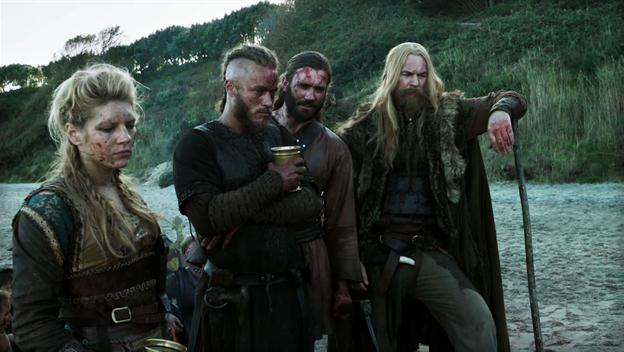Diane Haithman is an AwardsLine contributor.
In the first episode of History’s Vikings, lead character Ragnar Lothbrok (Travis Fimmel) can barely contain his excitement as he tries to persuade brother Rollo (Clive Standen) that Viking ships might venture West to discover what new cities and new gods might be found in uncharted territory. How, wonders Rollo, can a ship stay true to its course with no land in sight?
Ragnar shows Rollo the sunboard, a disc that floats on water and charts direction by the location of the noon shadow. Rollo remains skeptical: What happens when clouds obscure the sun? Ragnar then unwraps the precious sunstone, a crystal whose reflective properties can pinpoint the sun’s position even in blinding fog.

The sunstone had long been part of Viking legend when Justin Pollard, historical consultant and associate producer of Vikings (History’s first scripted series), suggested to series creator-writer Michael Hirst that the sunstone (actually a calcite crystal called Icelandic spar) be woven in the story.
But it came as a surprise when, less than two weeks after the series’ March 3 premiere, news reports broke that a piece of the crystal had been discovered in a shipwreck from the later Elizabethan period, suggesting that the “magic gem” of Viking legend was not only real, but the navigational tool was borrowed by other cultures and used for centuries after the Vikings sailed the seas.
“Justin is my anchor,” Hirst says. “It’s his input which anchors my stories in the real and the true. I needed to give Ragnar, my hero, some piece of knowledge so useful and special that it both marked him out from other men and also pushed the story forward.” Finding hard evidence of the sunstone after the fact, Hirst says, was the icing on the historical cake.
In a telephone interview from his home in Dorset, England, Pollard—historical consultant for film and TV productions including Les Misérables, numerous Working Title films including Atonement and Elizabeth and Showtime’s series The Tudors, also created by Hirst—says it’s all about using concrete clues to create what might have been.
“As a writer, you can imagine a more primitive world, but it’s very hard to imagine what’s now missing, what they used to have that’s gone,” Pollard says. “That’s what I try to do.”
Pollard feels a particular obligation to illuminate the truth about Viking culture, defined in the mind of the general public by horned helmets (they didn’t wear those) or Bugs Bunny’s animated romp through Wagnerian opera in What’s Opera, Doc?
“It’s about making a bigger world. Not every Viking was a warrior,” Pollard says. He is particularly proud of bringing to light the role of women, who were more independent and powerful than in much later periods of European history.
Pollard acknowledges that History draws an unusually well-read audience. “We did have one instance where Athelstan (George Blagden) is speaking Anglo-Saxon, and someone said his Anglo-Saxon didn’t have enough of a Northumbrian accent,” he recalls. Pollard was less annoyed than awed that a viewer knew Anglo-Saxon well enough to discern the regional accent.
Pollard says his biggest challenge is speed. Being able to locate an expert on Latvian hats at, well, the drop of a hat—or getting “the call at 3 in the morning saying, ‘We could do with a bit of Norse swearing. Can I have it in an hour?’”
But speed can have its advantages. The creative team can access the most recent academic research and bring it to a general audience far more quickly than the classroom can. “That’s the best thing about comparing an academic historian’s role to doing this—I get to wander through these places, and live in these times,” Pollard says. “You see characters brought to life on the screen more quickly than you do in academia.”
Pollard said re-creating a real historic period can be more rewarding than inventing a fantasy past for a series such as Game of Thrones. “It’s beautiful, it’s strange, but nothing is particularly surprising in a fantasy world,” he says. “The beauty of historical drama is you can find the beautiful and the strange in things that really did happen.”

